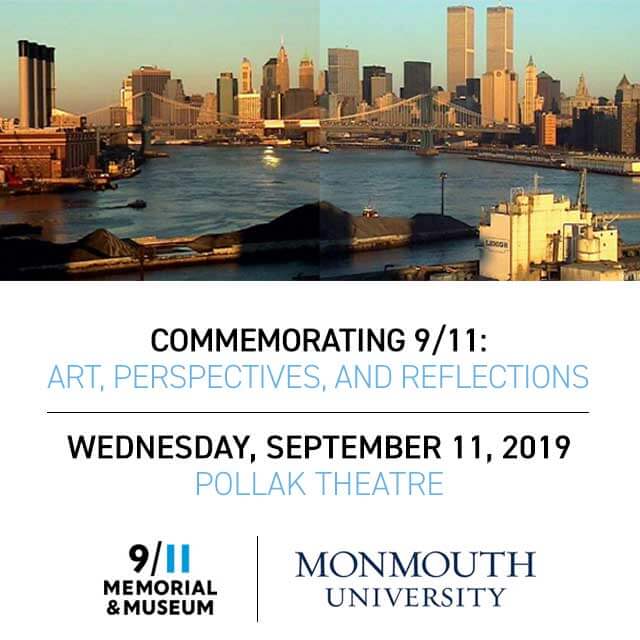
Commemorating 9/11: Art, Perspectives, and Reflections

Wednesday, Sept. 11, 2019 7 a.m.-9 p.m.
Video Screening
“2001” by Wolfgang Staehle
Pollak Theatre
Sept. 11, 7 a.m.–7 p.m.
From 7 a.m. until sunset, Monmouth University will present a free public viewing of artist Wolfgang Staehle’s dual-channel video work “2001.” This rare footage recorded the launch of the terrorist attacks on America from a pair of unmanned webcams.
Several days before September 11, 2001, Staehle, a pioneering internet artist, had situated two cameras in an apartment building in Brooklyn, focused on lower Manhattan. They were calibrated to continuously snap panoramic views of New York City, at four-second intervals, for live-streaming to the Postmasters Gallery in Manhattan. The installation was intended to convey the predictable normalcy of life at the start of the 21st century. Instead, Staehle’s cameras bore witness to the unexpected rupture of those mundane rhythms at the moments framing 8:46 a.m., when hijacked Flight 11 exploded through the North Tower of the World Trade Center. Staehle’s webcams continued to document lower Manhattan’s skyline for the next three weeks.
Monmouth University’s Pollak Theatre will show an excerpt of Staehle’s video work in real time throughout the day, and viewers are invited to stay for as much or as little of the footage as they would like. Presentation of this program is made possible through the generous support of the 9/11 Memorial Museum Presenting Sustainer Cantor Fitzgerald Relief Fund.
Panel Discussion
Pollak Theatre, 7 p.m.
At approximately sunset, Monmouth University President Patrick F. Leahy, Ed.D. welcomes all to a panel discussion moderated by Monmouth University Interim Provost and Vice President for Academic Affairs Rekha Datta, Ph.D., featuring the varied perspectives of those impacted by the events of September 11, 2001. Hear from Virginia S. Bauer, a member of the Board of Directors for the 9/11 Memorial & Museum, as well as University faculty members Douglas Collier, M.A., John Comiskey, Ed.D., Christopher DeRosa, Ph.D., and Melissa S. Ziobro, M.A.
After her husband was killed at the World Trade Center, Virginia S. Bauer became a key activist on behalf of the families of the 9/11 victims. In her role as advocate for the 9/11 victims, Bauer worked closely with congressional leaders and the White House to achieve the successful enactment of 9/11 victim legislation in 2002. She is the CEO of GTBM Inc. in East Rutherford, New Jersey, which provides software security technology for law enforcement and corporate facilities. Bauer is also a member of the Monmouth University Society of Trustees.
Douglas Collier, who worked as a federal agent at the time of the September 11, 2001 attacks, is the director of professional outreach and engagement for Monmouth University’s graduate program in criminal justice and also serves as a faculty member with a special focus on federal, state, and international global studies in criminal justice. A retired DEA agent, he is also a State of New Jersey Police Training Commission certified instructor and professor, a member of the New Jersey State Association of Chiefs of Police, and an associate academic member of the International Association of Chiefs of Police.
A retired New York City Police Department lieutenant, John Comiskey served as a first responder on September 11, 2001. He is a faculty member in the University’s criminal justice department, leading coursework in intelligence, evidence-based counter-terrorism operations, and the nexus of crime and terrorism for the University’s homeland security program. Comiskey’s undergraduate and graduate homeland security courses include the many lessons learned from the 9/11 terrorist attacks. He leads a Terrorism in New York City tour that features Ground Zero as well the 1920 Wall Street bombing, the 1979 Fraunces Tavern Bombing, and the 2017 West Side Truck Attack. Comiskey is also a member of the U.S. Coast Guard Reserve and serves as an intelligence specialist.
Christopher DeRosa is the chair of the department of history and anthropology at Monmouth University. He teaches undergraduate and graduate courses in the military and political history of the United States. His first-year seminar on the Iraq and Afghanistan Wars includes dedicated lessons on the September, 11, 2001 attacks. As part of the seminar, he leads student trips to the 9/11 Memorial & Museum.
Melissa Ziobro is a public historian and educator, who helped document both 9/11 response efforts and the subsequent global war on terror for the United States Army. She is a specialist professor of public history in the University’s Department of History and Anthropology, where her classes often explore issues of memory and commemoration.
Oops! We could not locate your form.
Gallery Exhibit
BEYOND GROUND ZERO: 9/11 AND THE AMERICAN LANDSCAPE
Photographs by Jonathan C. Hyman
Open Sept. 3–13
On the afternoon of September 11, 2001, Jonathan C. Hyman, an artist and photographer based in upstate New York, embarked on a journey to document responses to the 9/11 terrorist attacks appearing in the landscape around him.
Armed almost daily with his camera, ladder, and car, Hyman captured the grassroots expressions of everyday citizens spurred by this national catastrophe. His investigations took him from Maine to Florida and west to Illinois, though the majority of photographs were taken closer to New York City. The result is an expansive archive of more than 20,000 film and digital images. Hyman encountered improvised tributes and memorials on public and private property, in urban and rural areas, and on all manner of surfaces from building walls, handball courts, and vehicles to tree trunks, construction fencing, and human skin. He continued to document these unofficial memorials for years, many of which remained long after the emergence of more formal tributes.

